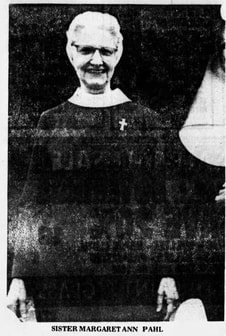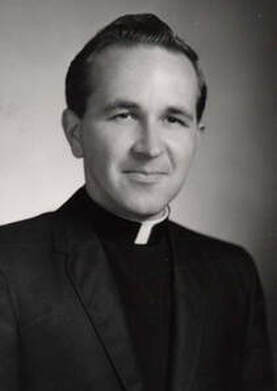 By M.P. Pellicer | Stranger Than Fiction Stories Sister Margaret Ann Pahl was stabbed to death on April 5, 1980, Holy Saturday and the day before her 72nd birthday. There was nothing random about the identity of this victim, or when she was killed.  Sister Pahl c.1950s Sister Pahl c.1950s In 1968, Sister Annunciata became Sister Margaret Ann Pahl. Only two years before the Sisters of Mercy had allowed the nuns to use their baptismal names. She had taken the habit over 50 years before. In 1980, she lived on the top floor of Mercy Hospital in Toledo, Ohio, which served as a convent for seventeen nuns. The discovery of her body in the sacristy of St. Joseph's Chapel in the hospital shocked employees. Police speculated she was murdered early that morning while preparing for Holy Saturday services. The coroner later determined she had been stabbed as much as 32 times, strangled and sexually molested. Her dark blue habit was pulled up to her chest, and her girdle and underwear had been pulled down to her ankles. The police questioned witnesses and searched for physical evidence, but a year later there had been no arrests. The employees took up a collection for money and the county government offered another $10,000 in reward for information. The $24,000 incentive did not produce any viable clues, much less a suspect. Twenty-four years would pass before police caught a culprit, and it was the unlikeliest of persons, or so it seemed. In 2003, the case was reopened after a tip was called into the Lucas County prosecutor's office. Now there was new technology known as blood transfer patterns. This brought investigators to re-interview Rev. Gerald Robinson, 66, who during the initial investigation was considered one of several suspects. Ironically Robinson had performed the funeral for Sister Pahl. Father Robinson and Sister Margaret Pahl worked together, since he was one of two chaplains for the hospital. The lead that caused the case to be reopened came in the form of a woman alleging that Rev. Robinson had sexually abused her during bizarre rituals. To be exact, she described them as satanic and sadomasochistic ceremonies, which were attended by several priests. New information about the murder scene was publicized in 2004. Sister Pahl's body was surrounded by candles with her arms extended unnaturally at her side, and an altar cloth was draped over her body. She was posed to look as though she had been sexually assaulted, but police found no evidence of sexual activity. Investigators accurately described the crime as a ritualistic killing. Authorities admitted they had never suspected robbery as a motive, since Sister Margaret's purse and several gold crucifixes near her body were not taken. No fingerprints or footprints were found, and it was believed the killer used a small knife.  Sister Pahl when she was still Sister Annunciata Sister Pahl when she was still Sister Annunciata Father Robinson's office was steps away from the chapel, which was tucked away in the hospital. He was one of several suspects the police were hoping to find solid evidence on, at the beginning of the investigation. An employee interviewed at the time of the murder, who worked in the emergency room said, "It was somebody who would have had to know what Sister's habits were. It had to be somebody who knew the territory and knew the routine. That leaves you with very few people." She described Father Robinson as quiet and aloof. Not too long after the murder, Robinson was appointed pastor of three parishes in Toledo in 1981, and he left the hospital. In 1989, he moved to a church in suburban Toledo, and five years later became chaplain at Flower Hospital and Lake Park Nursing Home. On June 11, 2003, the woman whose allegation reopened the case, testified before the Diocesan Review Board and wrote a detailed statement alleging years of abuse by Toledo priests during her childhood. Now she was in her 40's, and described satanic ceremonies in where she was placed in a coffin filled with cockroaches, and forced her to swallow what she believed was a human eyeball. She was penetrated with a dead snake, which had been decapacitated to "consecrate these orifices to satan." She alleged the clerics killed an infant, a 3-year old child, performed an abortion on her and mutilated dogs during the rituals. She also accused another priest named Chet Warren. By 2003-04, Warren's whereabouts were unknown and he had been banned from ministry. Allegations against him for ritualistic abuse surfaced in the mid-to late-1980s. One of his victims said he had abused her for 4 years starting in 1969, when she was 13 years old. The accuser of both priests, Chet Warren and Gerald Robinson was a Catholic nun. She was one of several who came forward to describe abuse at the hands of these men, and others under similar circumstances. By then about a dozen persons were being represented by attorney Catherine Hoolahan. She said the victims, both men and women could not recall how many priests abused them, but this was not surprising since they were children and scared. Father Robinson was described by parishioners in the blue-collar, Polish neighborhood where he worked as shy and dedicated. He spoke fluent Polish and was popular in the area. At the time of his arrest in 2004, he was performing pastoral care at nursing homes and hospitals in Toledo. The Diocese of Toledo decided against paying Robinson's legal bills and suspended him. The members of St. Anthony's Church took a collection for his defense fund. Described as being a generous man, Robinson's former secretary at St. Anthony said, "Sometimes, I thought he was too generous."  A witness testifying at Rev. Robinson's trial for the murder of Sister Pahl (Source AP) A witness testifying at Rev. Robinson's trial for the murder of Sister Pahl (Source AP) Louis Schlesinger, a forensic psychology professor said, "Ritualistic behavior in murder is almost always associated with sexually motivated murder where the ritualistic conduct is carried out because the murder itself would not satisfy the person psychosexually." He explained it was common for a sexual offender to kill one victim, but not another. In the days after the murder, police had taken a letter opener with a unique medallion from Robinson's room. There was also a stained linen found outside the hospital chapel, which was believed to be a key piece of evidence. Dave Davison investigated Sister Pahl's murder in 1980. He was eating breakfast with another officer in Mercy Hospital's cafeteria. Suddenly a nurse yelled, "There's a dead nun." When they arrived at the chapel there were three doctors, eight nurses and several nuns trying to revive the dead woman. Davison began talking to them about who could have committed the crime, and he heard the same answer repeatedly, "Father Robinson" or "the priest." In May, 2004, when he was retired he said, "This is no secret. From day one, they said he did it." He believed that high-ranking, Catholic police bosses didn't allow an aggressive investigation of the case. On May 4, 2004, Robinson walked out of jail on a $200,000 bond which was paid by his supporters. Several days later he pleaded innocent to an aggravated murder charge. If convicted he faced life in prison, and not the death penalty since it was not in effect in Ohio at the time of the killing. In mid-July, Sister's Pahl's body was exhumed for a new forensic examination. The coroner who had examined the corpse originally had died. Sister Pahl was buried next to a large statue of Jesus at Bernadine Cemetery, which is the final resting place for all the Sisters of Mercy who lived in the Midwest. Robinson did not go to trial until February, 2005. By then police searched an abandoned house in Lucas County where people were reportedly taken as part of abuse ceremonies. They were looking for evidence of cult gatherings in church attics and basements. They interviewed experts on subversive groups and church history. They also spoke to a founder of a secret fraternity whose members dressed in nuns' clothing. During the trial it came out the Robinson had failed one of two lie detector tests in the days after the murder. The failed test indicated he was involved in Sister Pahl's murder. A second test given a few months later showed he was telling the truth. In February, 2006, it came out that shortly after the murder Robinson had told police that someone had come forward and confessed to killing the nun. He later told investigators he lied about the confession because he wanted to deflect a detective's accusatory tone during an interrogation. During the hearing, an investigator testified that an altar cloth found near the body had blood transfer patterns that matched those from a sword-shaped letter opener police found in Robinson's office in 1980. Robinson had told police he had "exclusive control of the knife." During the trial the prosecutor said the blade found in the priest's room fit the nun's wounds "like a key in a lock." The medallion on the letter opened was the size of a dime and had an image of the U.S. Capitol on one side. Robinson had lied about having a key to the chapel sacristy where the body was discovered. Two nuns who had been the first to discover Sister Pahl testified at the trial. Sister Madelyn Marie Gordon the chapel organist who first found the body, said she first thought the body was a mannequin used to teach resuscitation because of its strange position, which later she realized was posed unnaturally. The other nun, Sister Phyllis Ann Gerold said she remembered the nun's face was swollen, and there was no blood. She also testified the victim's genital area was exposed. The nuns said that Sister Pahl's 2-inch cross pin and watch, as well as a pair of scissors were missing. They described Sister Pahl, as strict but devoted and giving.  Father Grob testified on symbolism tied into an inverted cross stabbed in the sister's chest Father Grob testified on symbolism tied into an inverted cross stabbed in the sister's chest A coroner testified that the letter opener when inserted into a wound on the nun's jaw, was a perfect fit. She also confirmed that of 31 stab wound to the face, neck and chest, nine were in the shape of an upside-down cross. Investigators testified that the letter opener when taken from Robinson's desk didn't have any fingerprints, stains or smudges. One said, "It was sumptuously clean. It appeared that it had been polished. That was interesting." A housekeeper testified that the day before her death Sister Phal was upset about changes being made to the Easter weekend services. The nun had told her: "Why do they cheat God out of what belongs to him?" She didn't specify which of the two chaplains she was upset at. A maintenance man who was cleaning floors the morning Sister Phal was killed, testified he heard fast-moving footsteps in a hallway above. This hallway led to Robinson's living quarters in the hospital. He said it was odd because most of the building was empty. He thought the footsteps stopped short of Robinson's room. The prosecutors brought experts on Roman Catholic law and the occult. Father Grob testified that an upside-down cross is used in satanic worship. He said that only a priest, nun or seminary student would understand the significance of the inverted cross and other aspects of the crime scene, including a small streak of blood on the nun's forehead that could have been made by someone forming the sign of the cross on her head. He said, "You're taking a person who's devoted to God and in every aspect, it's a mockery. These aren't random acts." The altar cloth placed over her chest before she was stabbed could be viewed as a symbol of sacrifice.  Dr. Dawn Perlmutter Dr. Dawn Perlmutter Dr. Dawn Perlmutter who ran a private organization that provided specialized crime-scene identification, and criminal investigation assistance to police departments around the world assisted the prosecution. She had been working in this field for 15 years, and had assisted in the murder of Sister Mary Laura Manetti in 2000 in Italy. In an interview Dr. Perlmutter said that regarding the murder of Sister Pahl it, "was about as classic as it gets" for a satanic ritual. She pointed out the site of the crime indicated a satanic ceremony. Desecration of sacred space enhanced the magical power of the ritual. This setting was "ritually required" for traditional satanists. The timing, on Holy Saturday, intensified the defilement. Sacred holidays hold special significance for the true believers. The victim being a dedicated servant of God would be considered a great accomplishment for the perpetrator. The sacred objects surrounding the murder scene also reinforced the murder as being ritualistic. This was evident with the arrangement of the candles, and the use of the altar cloth. Dr. Perlmutter theorized the murderer stabbed the nun so many times, not in anger, but to draw more blood from her body to complete the ritual. Since he had strangled her to the verge of death, her heart was not circulating much blood through her body. There was a circular bruise in her chest area, which she believed was made when the perpetrator pressed the lips of a chalice to the wound to fill it with blood. The inverted cross on Sister Pahl's body is "very common in satanic crimes" Dr. Perlmutter explained. The stab wound were all on the left side of the body, which was another nod to the Left Hand Path. Despite prior reports that Sister Pahl had not been raped, the coroner found she had been penetrated by an unspecified "instrument". Dr. Perlmutter explained this was not done for sexual gratification, but as part of the ritual. She believed the instrument used to desecrate the sister's body was probably a cross. She also explained that in all her years of investigating ritual violence, perpetrators never get rid of knives they had used in a ritual, which explained why Father Robinson held onto the letter opener. It was inscribed with two pentagrams on one side of the handle.  Sister Pahl Sister Pahl The jurors were shown a 90-minute video of Robinson's interview with police after he was arrested in 2004. He said he woke up and had finished showering when he received a phone call about Sister Pahl's death, and that he was nowhere near the crime scene. He told the investigator that the other chaplain Rev. Jerome Swiatecki had accused him of committing the crime. He said he was stunned when he arrived at the sacristy and Swiatecki said, "Why did you do this?" He said he couldn't understand why the other priest would accuse him. Three hospital employees testified they saw Robinson just outside the building's chapel within an hour before her body was found inside. One said he saw Father Robinson coming out of the chapel doors with a dark duffel bag in his hands. Another witness was Dr. Jack Baron, who said he ran towards the chapel when he heard an emergency call over the speaker. He mistakenly ran past the chapel, and saw another man walking towards it wearing black garments and a priest's collar. The man in the hallway looked over his should at him, and he described it as: "He gave me a stare that went right through me." When he turned around and ran back to the chapel, the priest was no longer around. Former police detective Arthur Marx testified that whoever killed Sister Pahl was not a stranger because there were so many stab wounds. "It was someone very angry, " he said. The reports he had made of his interview of Robinson and the other chaplain had gone missing, but were later found. The prosecution said that the murder of Sister Pahl was sparked by Robinson's anger over her domineering ways. On May 11, 2006, Robinson was convicted of murdering Sister Pahl. He was immediately sentenced to the mandatory term of 15 years to life in prison and was taken away in handcuffs. During the search of Robinson's room in 2004 police found several hundred photos of caskets and corpses, along with a pamphlet about the occult that was written by a Catholic organization. The defense attorney said Father Robinson collected these items because it was an old Polish custom.  Rev. Gerald Robinson c.2004 (Source - AP) Rev. Gerald Robinson c.2004 (Source - AP) In the aftermath of the trial, church and former police officials were accused of attempting to thwart the investigation in 1980, because of who the suspect was. Some believed there was a cozy relationship between police and the Toledo Catholic Diocese's hierarchy. A retired detective testified that his interview with Robinson in 1980, ended abruptly when the deputy chief at that time, and a priest from the diocese stopped the interrogation being conducted on April 19. The priest in question was Monsignor Jerome Schmit, a cigar-smoking cleric who was ordained in 1941. By 1980, he had become one of Toledo's most powerful church leaders. After this intervention, the investigation went nowhere. The Church's influence in Toledo extended back to the 1950s. Gene Fodor who served on the Toledo police force from 1960 to 1987 said officers wouldn't dare arrest a priest, because they would have been fired. He described when in 1960, parishioners in a working-class neighborhood complained to him about Father Alexander Pinter, because they believed he was molesting altar boys at a lakefront cottage. They were outraged the police were not doing anything about it, but he couldn't tell them that he wasn't permitted to do anything about it. Finally Fodor's superiors spoke with Bishop George Rehring, and told him either he did something about Father Pinter or they would. In July 1960, the priest then 41, entered a treatment center in Canada. His departure from Ohio had been quiet and quick. Later he taught in seminaries in the United States, and served in two parishes in the Diocese of Oakland. By the 1970s, he was working in Louisiana, and he died before the decade was out. He was never held responsible for his crimes. Prosecutors said that when Sister Pahl was killed witnesses were reluctant to implicate a priest, however after the scandal of child sex abuse at the hands of priests rocked the Catholic church this reticence had changed.  Rev. Gerald Robinson c.1968 Rev. Gerald Robinson c.1968 In September, 2006, four months after Father Robinson's conviction the crime was still causing controversy in the parish where he served. A church bulletin announced a chicken-dinner fundraiser for him, however this caused a protest from some parishioners. An email was sent to the bishop who said the item was inappropriate, and his office said they had not granted permission for the ad to be placed. Even though it was not sanctioned, more than 100 people donated a minimum of $15 for the dinner. The money was to help pay for Robinson's appeal. In January, 2007, the civil lawsuit against Robinson was dismissed. The woman who accused him of taking part in ritual abuse ceremonies 40 years before, was told the statute of limitation had expired. In 2011, the Ohio Supreme Court declined to hear the case. In 2008, an appeals court upheld Robinson's conviction, and in 2009 the Supreme Court declined to hear Robinson's appeal.  Rev, Robinson's letter opener which was believed to have been the murder weapon Rev, Robinson's letter opener which was believed to have been the murder weapon In 2011, attorneys representing Robinson claimed that a deceased serial killer could have been the one who stabbed and strangled her. They were speaking of Coral Eugene Watts who died in a Michigan prison in 2007. He lived less than an hour away from Toledo, and fit the description of witnesses who said they saw a young, thin black man at the hospital. One of Robinson's original defense lawyers said he had not considered Watts, because he was known to stalk and kill young women when they were outside. Watts was a suspect in more than 25 slayings and may have killed more than 80 women. He had confessed to 12 killings, 11 in Texas and one in Michigan. A former Toledo police detective testified that Watts once told another investigator he never killed anyone in Toledo. That same year of 2011, a 136-page police report dating back to 1980 was discovered, however in 2012 a judge ruled that the reports didn't contain any new information that would have changed the outcome. Robinson died July 4, 2014, and many parishioners in the Diocese of Toledo where shocked to learn that his body was buried with full priestly rights. Within weeks of Robinson's burial, a site devoted to selling memorabilia from notorious killers was selling dirt said to be from Robinson's gravesite. The sale also included a photo of Robinson in his coffin. Sources - Sin, Shame and Secrets (Yonke, 2006), The Cincinnati Enquirer, The Cincinnati Post, The Marion Star, The News Messenger
0 Comments
Your comment will be posted after it is approved.
Leave a Reply. |
Stranger Than Fiction StoriesM.P. PellicerAuthor, Narrator and Producer Archives
July 2024
Categories
All
|
Stories of the Supernatural
- Stories of the Supernatural
- Miami Ghost Chronicles
- M.P. Pellicer | Author
- Stranger Than Fiction Stories
- Eerie News
- Supernatural Storytime
-
Astrology Today
- Tarot
- Horoscope
- Zodiac
-
Haunted Places
- Animal Hauntings
- Belleview Biltmore Hotel
- Bobby Mackey's Honky Tonk
- Brookdale Lodge
- Chacachacare Island
- Coral Castle
- Drayton Hall Plantation
- Jonathan Dickinson State Park
- Kreischer Mansion
- Miami Biltmore Hotel
- Miami Forgotten Properties
- Myrtles Plantation
- Pinewood Cemetery
- Rolling Hills Asylum
- St. Ann's Retreat
- Stranahan Cromartie House
- The Devil Tree
- Trans-Allegheny Lunatic Asylum
- West Virginia Penitentiary
- Paranormal Podcasts
"When misguided public opinion honors what is despicable and despises what is honorable, punishes virtue and rewards vice, encourages what is harmful and discourages what is useful, applauds falsehood and smothers truth under indifference or insult, a nation turns its back on progress and can be restored only by the terrible lessons of catastrophe."
- Frederic Bastiat
- Frederic Bastiat

Copyright © 2009-2024 Eleventh Hour LLC. All Rights Reserved ®
DISCLAIMER
DISCLAIMER
 RSS Feed
RSS Feed
















